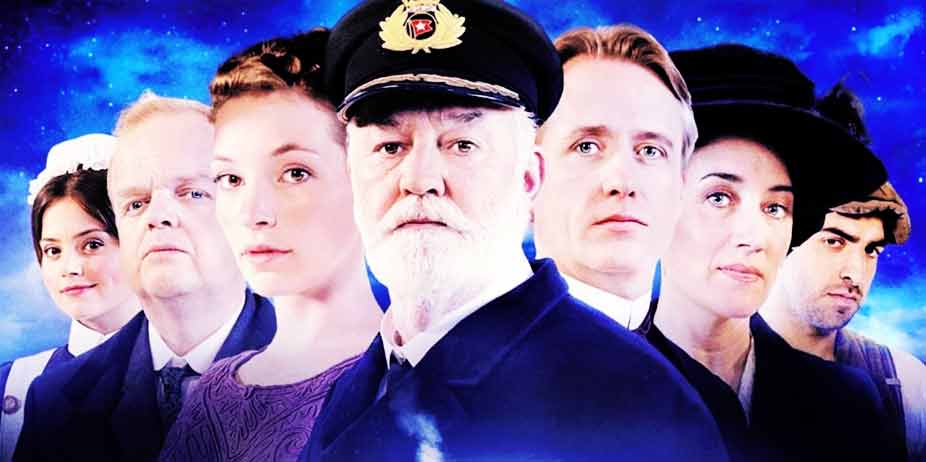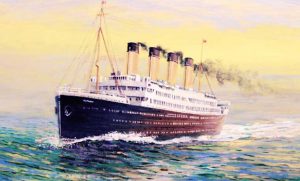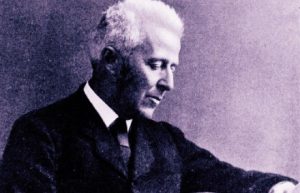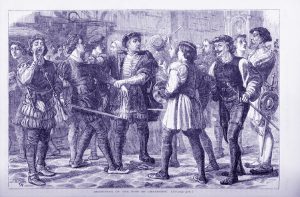
Since I first fell in love with the stories surrounding the ill-fated ocean liner at age thirteen, I have read and watched anything I can get my hands on pertaining to the ship. For someone who knows nothing about Titanic, and who hasn’t seen the James Cameron film, this miniseries by Julian Fellowes is entertaining but nothing to write home about.
With the suffragist movement sweeping across England, Lord Manton (Linus Roache) has trouble keeping his daughter Georgiana (Perdita Weeks) in line. Her recent escapade landed her in the local lock-up, and out of desperation, he decides a change of scenery might do her good. Enlisting the help of his friend Bruce Ismay (James Wilby) to book Georgiana a first-class cabin on the maiden voyage of the RMS Titanic, he hopes a stint in New York will put her mind to better uses than feminism. Also on board, in second-class, is his employee John Batley (Toby Jones) and his wife Muriel (Maria Doyle Kennedy). It doesn’t take long for Muriel to clash with Lady Louisa (Geraldine Somerville) and let out secrets Lord Manton did not want made known into public knowledge.
Meanwhile, stewardess Annie (Jenna-Louise Coleman) is being wooed by an Italian last-minute steward Paelo (Glen Blackhall), who fears once they land in America, he may never see her again. The servants of the Grex family share a secret that could endanger them, an anarchist sets his intentions on another man’s wife in steerage, and Second Officer Charles Lightoller (Steven Waddington) copes with a shuffle in position.
Trying to reproduce the tragedy on this topic on television is no enviable task since it has nowhere near the budget it needs. Other series and movies worked around that, but unfortunately this vision gets hampered by a rushed narrative that insists on a reset for the first three installments. It carries the audience through events up to the sinking and then returns to the beginning to tell a different story. This format hinders us from emotional involvement with established characters and limits our scope, both for the actual figures of the disaster and the ship. That none of the staterooms, the first-class dining room, or the deck resembles the real thing is less important than how the production feels claustrophobic. The rooms are so small and our interludes kept to so few figures that we never really get to see what an incredible achievement Titanic was, much less how many people were on board. The sinking scenes are crowded, but not the dining rooms. Fellowes’ script also makes appalling mistakes, ranging from mixed church sessions on board ship to the behavior and placement of individual figures during the sinking.
Various miniature love stories unfold and there are times we get drawn into the emotions of the moment, but alas, we get to know no one well, so when their fate transpires, we want to feel more than we do. The lack of a memorable score makes the emotions in many important scenes fall flat. Characters are introduced and nothing is done with them. Thomas Andrews simply disappears. Officer Lowe is manning the wrong boat. The Duff-Gordons are painted in an unduly harsh light.
Television has needed a decent miniseries on this topic for a long time, but this isn’t it. It would work better with events unfolding together, leading up to the sinking. It needed to revolve around one or two main characters, not a dozen. It’s a shame no one edited it into a linear plot, since I suspect I might have enjoyed it more.
SEXUAL CONTENT: One adulterous kiss and references to extramarital affairs; upper-class individuals are shocked to find a man traveling with his mistress. They are shown in bed together (she gets up and we see her bare back briefly).
VIOLENCE: A man’s neck is broken; people drown.
Want more stories set aboard the doomed Titanic and in the heart of Edwardian Belfast? Discover The Secret in Belfast, where faith, fate, and a siren’s song intertwine with the lives of real historical figures.
TITANIC HISTORICAL ERRORS
I noticed these historical errors while watching the miniseries…
- The White Star Line did not bring Murdoch on board and demote Lightoller to Second Officer, but Captain Smith did.
- Titanic was nowhere near full capacity (thus, Lord Manton would have had no trouble booking first-class cabins for his family).
- There were no Italian stewards, stokers, or passengers on board other than two men in steerage.
- Where is Thomas Andrews’ Irish accent?
- The Batley’s vehicle is green, which means it’s a post-WW1 model-T Ford.
- There was no dancing in first or second class on board the ship.
- Lightoller is not on duty when he ought to be; he is also fraternizing and dancing with a first-class passenger (which would never happen).
- Multiple times, the ship is shown sailing in the wrong direction.
- Colonel, Mrs. Astor, and Thomas Andrews are shown playing cards prior to the collision; in reality, all three were in their cabins.
- Locked, full-length gates are shown to keep third-class passengers below decks (they did not exist).
- Colonel Astor’s wife is placed into a lifeboat a full hour ahead of the historical account, and into the wrong lifeboat, on the wrong side of the ship, on the wrong deck level.
- Rockets are fired from the stern, rather than the forward boat deck.
- Steerage passengers were not allowed into first class for the Sunday church service (2nd class had their own service, and in third class, a Catholic priest presided over mass). Other third-class passengers are later in first class sections of the ship, which never would have happened.
- Moody says they are only loading first class ladies into the boats (all ladies were loaded).
- Lowe leaves the ship in the wrong boat, an hour later than he departed, from the wrong side of the ship.
- Astor is crushed when the funnel falls; historically, his body was intact.
- The forward funnel falls in the wrong direction.
- The Countess of Rothes was never in the same boat as Margaret Brown.







